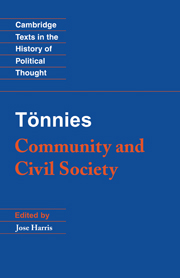Book contents
- Frontmatter
- Contents
- Acknowledgements
- General introduction
- Chronology of Tönnies's life and career
- A note on the texts and further reading
- A note on translation
- Glossary
- COMMUNITY AND CIVIL SOCIETY
- Book One A general classification of key ideas
- The argument
- Section 1 The theory of Gemeinschaft
- Section 2 The theory of Gesellschaft
- Book Two Natural will and rational will
- Book Three The sociological basis of natural law
- Appendix: Conclusions and future prospects
- Index
- CAMBRIDGE TEXTS IN THE HISTORY OF POLITICAL THOUGHT
Section 1 - The theory of Gemeinschaft
Published online by Cambridge University Press: 05 June 2012
- Frontmatter
- Contents
- Acknowledgements
- General introduction
- Chronology of Tönnies's life and career
- A note on the texts and further reading
- A note on translation
- Glossary
- COMMUNITY AND CIVIL SOCIETY
- Book One A general classification of key ideas
- The argument
- Section 1 The theory of Gemeinschaft
- Section 2 The theory of Gesellschaft
- Book Two Natural will and rational will
- Book Three The sociological basis of natural law
- Appendix: Conclusions and future prospects
- Index
- CAMBRIDGE TEXTS IN THE HISTORY OF POLITICAL THOUGHT
Summary
In tune with the argument so far, the theory of Gemeinschaft is based on the idea that in the original or natural state there is a complete unity of human wills. This sense of unity is maintained even when people become separated. It takes various forms, depending on how far the relationship between differently situated individuals is predetermined and ‘given’. The common root of these relationships is the all-embracing character of the sub-conscious, ‘vegetative’ life that stems from birth: human wills, each one housed in a physical body, are related to one another by descent and kinship; they remain united, or become so out of necessity. This direct mutually affirmation is found in its most intense form in three types of relationships: namely, (1) that between a mother and her child; (2) that between a man and a woman as a couple, as this term is understood in its natural or biological sense; and (3) that between those who recognise each other as brothers and sisters, i.e. offspring at least of the same mother. While the seed of Gemeinschaft, or the bias of human minds towards it, is to be seen in any relationship of kinsfolk, these three are of special importance as containing the seeds which are strongest and most readily nurtured. Each of them is significant in it own special way.
- Type
- Chapter
- Information
- Tönnies: Community and Civil Society , pp. 22 - 51Publisher: Cambridge University PressPrint publication year: 2001



